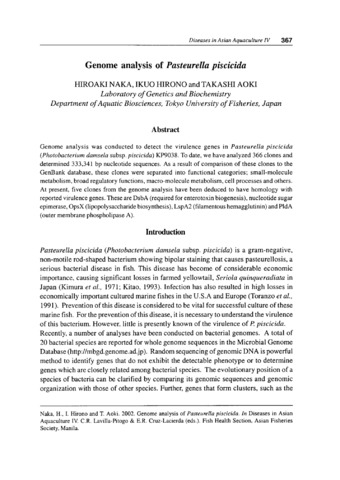Molecular typing of Vibrio parahaemolyticus strains isolated from the Philippines by PCR-based methods
| dc.contributor.author | Maluping, R. P. | |
| dc.contributor.author | Ravelo, C. | |
| dc.contributor.author | Lavilla-Pitogo, C. R. | |
| dc.contributor.author | Krovacek, K. | |
| dc.contributor.author | Romalde, J. L. | |
| dc.date.accessioned | 2013-09-18T15:48:58Z | |
| dc.date.available | 2013-09-18T15:48:58Z | |
| dc.date.issued | 2005 | |
| dc.identifier.citation | Maluping, R. P., Ravelo, C., Lavilla-Pitogo, C., Krovacek, K., & Romalde, J. L. (2005). Molecular typing of vibrio parahaemolyticus strains isolated from the philippines by PCR-based methods. Journal of Applied Microbiology, 99(2), 383-391 | en |
| dc.identifier.issn | 1364-5072 | |
| dc.identifier.uri | http://hdl.handle.net/10862/1668 | |
| dc.description.abstract | Aim: The main aim of the present study was to use three PCR-based techniques for the analysis of genetic variability among Vibrio parahaemolyticus strains isolated from the Philippines. Methods and Results: Seventeen strains of V. parahaemolyticus isolated from shrimps (Penaeus monodon) and from the environments where these shrimps are being cultivated were analysed by random amplified polymorphic DNA PCR (RAPD-PCR), enterobacterial repetitive intergenic consensus sequence PCR (ERIC-PCR) and repetitive extragenic palindromic PCR (REP-PCR). The results of this work have demonstrated genetic variability within the V. parahaemolyticus strains that were isolated from the Philippines. In addition, RAPD, ERIC and REP-PCR are suitable rapid typing methods for V. parahaemolyticus. All three methods have good discriminative ability and can be used as a rapid means of comparing V. parahaemolyticus strains for epidemiological investigation. Based on the results of this study, we could say that REP-PCR is inferior to RAPD and ERIC-PCR owing to the fact that it is less reproducible. Moreover, the REP-PCR analysis yielded a relatively small number of products. This may suggests that the REP sequences may not be widely distributed in the V. parahaemolyticus genome. Conclusions: Genetic variability within V. parahaemolyticus strains isolated in the Philippines has been demonstrated. The presence of ERIC and REP sequences in the genome of this bacterial species was confirmed. Significance and Impact of the Study:The RAPD, ERIC and REP-PCR techniques are useful methods for molecular typing of V. parahaemolyticus strains. To our knowledge this is the first study of this kind carried out on V. parahaemolyticus strains isolated from the Philippines. | en |
| dc.description.sponsorship | This work was supported in part by Grant AGL2003-09307-C02-00 from the Ministerio de Ciencia y Tecnologıá (Spain). R.P. Maluping thanks the Federation of European Microbiological Societies (FEMS) for the research fellowship to Spain and the Swedish Foundation for International Cooperation in Research and Higher Education (STINT) for the postgraduate scholarship. We are also greatful to Dr Angelo DePaola of the Gulf Coast Seafood Laboratory, US Food and Drug Administration (FDA), for verifying the strains by the tlh gene probe. | en |
| dc.language.iso | en | en |
| dc.publisher | Wiley-Blackwell | en |
| dc.subject | Typing | en |
| dc.subject | random amplified polymorphic DNA | en |
| dc.subject | Conserved sequence | en |
| dc.subject | Vibrio parahaemolyticus | en |
| dc.subject | Penaeus monodon | en |
| dc.subject | Philippines | en |
| dc.subject | Giant tiger prawn | en |
| dc.subject | Enterobacterial repetitive intergenic consensus sequence PCR, | en |
| dc.subject | Repetitive extragenic palindromic PCR | en |
| dc.title | Molecular typing of Vibrio parahaemolyticus strains isolated from the Philippines by PCR-based methods | en |
| dc.type | Article | en |
| dc.identifier.doi | 10.1111/j.1365-2672.2005.02571.x | |
| dc.citation.volume | 99 | |
| dc.citation.issue | 2 | |
| dc.citation.spage | 383 | |
| dc.citation.epage | 391 | |
| dc.citation.journalTitle | Journal of Applied Microbiology | en |
| seafdecaqd.library.callnumber | VF SJ 0789 | |
| seafdecaqd.databank.controlnumber | 2005-08 | |
| dc.subject.asfa | nucleotide sequence | en |
| dc.subject.asfa | microbiological strains | en |
| dc.subject.asfa | DNA | en |
| dc.subject.asfa | polymerase chain reaction | en |
| dc.subject.asfa | genomes | en |
| dc.subject.asfa | genetic isolation | en |
| dc.subject.asfa | microbiology | en |
| dc.subject.scientificName | Penaeus monodon | en |
Files in this item
| Files | Size | Format | View |
|---|---|---|---|
|
There are no files associated with this item. |
|||
This item appears in the following Collection(s)
-
Journal Articles [1258]
These papers were contributed by Department staff to various national and international journals.




